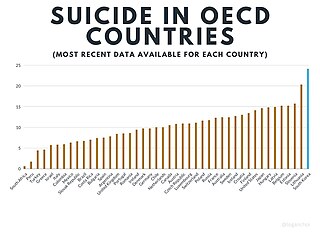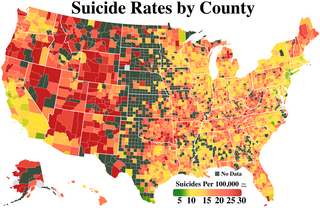According to a 2023 Centers for Disease Control and Prevention study, suicide is the second leading cause of death for adolescents between the ages of 10 and 14, and the third leading cause of death for those between 15 and 25
A suicide method is any means by which a person may choose to end their life. Suicide attempts do not always result in death, and a non-fatal suicide attempt can leave the person with serious physical injuries, long-term health problems, or brain damage.
There are more than 720,000 estimated global suicide deaths every year. Suicide affects every demographic, yet there are some populations that are more impacted than others. For example, among 15–29 year olds, suicide is much more prominent; this being the fourth leading cause of death within this age group.
In Japan, suicide is considered a major social issue. In 2017, the country had the seventh highest suicide rate in the OECD, at 14.9 per 100,000 persons, and in 2019 the country had the second highest suicide rate among the G7 developed nations.

Suicide is the act of intentionally causing one's own death. Mental disorders, physical disorders, and substance abuse are common risk factors.

South Korea has the fourth highest suicide rate in the world and the highest among OECD countries. The elderly in South Korea are at the highest risk of suicide, but deaths from teen suicide have been rising since 2010. In 2022 suicide caused more than half of all deaths among South Koreans in their twenties. It is the leading cause of death for those between the age of 10 and 39, in line with most OECD countries.

Gender differences in suicide rates have been shown to be significant. There are different rates of suicides and suicidal behavior between males and females. While females more often have suicidal thoughts, males die by suicide more frequently. This discrepancy is also known as the gender paradox in suicide.
World Suicide Prevention Day (WSPD) is an awareness day always observed on 10 September every year, in order to provide worldwide commitment and action to prevent suicides, with various activities around the world since 2003. The International Association for Suicide Prevention (IASP) collaborates with the World Health Organization (WHO) and the World Federation for Mental Health (WFMH) to host World Suicide Prevention Day. In 2011 an estimated 40 countries held awareness events to mark the occasion. According to WHO's Mental Health Atlas released in 2014, no low-income country reported having a national suicide prevention strategy, while less than 10% of lower-middle income countries, and almost a third of upper-middle and high-income countries had.

Suicide is a major national public health issue in the United States. The country has one of the highest suicide rates among wealthy nations. In 2020, there were 45,799 recorded suicides, up from 42,773 in 2014, according to the CDC's National Center for Health Statistics (NCHS). On average, adjusted for age, the annual U.S. suicide rate increased 30% between 2000 and 2020, from 10.4 to 13.5 suicides per 100,000 people. From 2000 to 2020, more than 800,000 people died by suicide in the United States. Males represented 78.7% of all suicides between 2000 and 2020. In 2022, a record high 49,500 people died by suicide. The 2022 rate was the highest level since 1941, at 14.3 per 100,000 persons. This rate was surpassed in 2023, when it increased to over 14.7 per 100,000 persons.
China's suicide rates were one of the highest in the world in the 1990s. However, by 2011, China had one of the lowest suicide rates in the world. According to the World Health Organization, the suicide rate in China was 9.7 per 100,000 population as of 2016; Among men, the rate was 9.1 per 100,000 population. As a comparison, the suicide rate in the U.S. in 2016 was 15.3. Generally speaking, China seems to have a lower suicide rate than neighboring Korea, Russia and Japan, and it is more common among women than men and more common in the Yangtze Basin than elsewhere.
According to the Australian Bureau of Statistics, the age standardised death rate for suicide in Australia, for the year 2019, was 13.1 deaths per 100,000 people; preliminary estimates for years 2020 and 2021 are respectively 12.1 and 12.0. In 2020, 3,139 deaths were due to suicide ; in 2021, 3,144 deaths were due to suicide.

Switzerland had a standardised suicide rate of 10.7 per 100,000 as of 2015. The actual (non-standardised) rate was 12.5 in 2014.

According to the latest available data, Statistics Canada estimates 4,157 suicides took place in Canada in 2017, making it the 9th leading cause of death, between Alzheimer's disease (8th) and cirrhosis and other liver diseases (10th). In 2009, there were an estimated 3,890 suicide deaths.
Suicide in Bangladesh is a common cause of unnatural death and a long term social issue. Of all the people reported dead due to suicide worldwide every year, 2.06% are Bangladeshi.
Suicide in Sri Lanka is a common cause of unnatural death and a long term social issue. In the past, Sri Lanka had one of the highest suicide rates in the world. For several years before 2000, the suicide rate remained at 35 to 47 per 100,000 persons. The introduction in pesticide control regulations coincided with a reduction in suicide rates in Sri Lanka. Sri Lanka Federation for Suicide Prevention is an independent organisation working on suicide prevention in Sri Lanka.
Suicide in Kazakhstan is a very common cause of unnatural death in the country and a long term social issue. According to the 2011 report of World Health Organization, of all the people reported dead due to suicide worldwide every year, 3.23% belong to Kazakhstan. Suicide of teenaged and young aged people is a big issue in the country. In the age group of 15-49 year olds, suicide makes up for 12.2% of all deaths in Kazakhstan.

Suicide in Greenland, an autonomous country within the Kingdom of Denmark, is a significant national social issue. Greenland has the highest suicide rate in the world: reports between 1985 and 2012 showed that an average of 83 people in 100,000 died by suicide yearly.
Suicide in Belarus is a common cause of unnatural death in the country, which in 2016 ranked in the top 10 worldwide by its total suicide per 100,000 people. Prior to the 1998 Russian financial crisis, suicide numbers had been decreasing year-upon-year, yet saw a noticeable increase in the years following.
Suicide in Ireland has the 17th highest rate in Europe and the 4th highest for the males aged 15–25 years old which was a main contributing factor to the improvement of suicides in Ireland.








